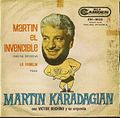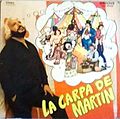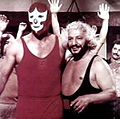Titanes en el ring
 Logo of Titans in the ring | |
 Martín Karadagián, the creator of the Titans | |
| Industry | Professional wrestling, Sports entertainment |
|---|---|
| Genre | wrestling |
| Founded | 1962 |
| Founder | Martín Karadagián |
| Defunct | 2001 |
| Headquarters | |
Area served | Argentina South America |
| Products | Television Publishing Films Music Merchandise Live events |
| Services | Licensing |
Titanes en el ring (Titans in the ring) was an Argentine lucha libre television program aired between 3 March 1962 and 1988.[1]
Background
The

In 1950s Karadagián fought against former heavyweight champion Primo Carnera.[4] And in 1957 he maintained a wrestling match in the stadium of Boca Juniors, against former boxer José María Gatica, el mono.[5] That same year, Karadagian starred in Reencuentro con la gloria, movie where a wrestler ("Pantera") accidentally killed a rival during a fight.[6]
In 1961 Karadagián fought at Luna Park against Capitan Piluso, played by actor Alberto Olmedo. Following the success of combat was filmed the movie Las aventuras del Capitán Piluso (En el castillo del terror) with Martín Karadagián in the role of villain.[7]
Titanes en el Ring
Martín Karadagián creates Titans in the ring in 1962, the TV show airs on
In 1964 José Luis López (el campeón español) joined in Titans, time after, Karadagiám hired the wrestlers Rubén Peucelle el Ancho, Pedro Bocos, Ulises, Humberto Reynoso El Caballero Rojo and Domingo Lucciarini Pepino el Payaso.
In 1970s Titanes en el Ring moved to Canal 13, Karadagián incorporates fantastic and mythological characters as El Vikingo, Don Quijote y Sancho Panza, D’Artagnan, el Mosquetero, El Acuanauta, Poseidon, El Cavernario, La Momia Negra and others.
In 1972 Karadagián faces La Momia for the world championship. The evening was held at the Luna Park stadium, with a draw.[13]
Other classic wrestling battles included Peucelle vs José Luis, Tenembaum vs Tufic Memet, El Coreano sun vs Silvio, Karadagián vs Ararat el armenio, Karadagián vs Durante, Mercenario Joe vs el Vasco Guipúzcoa, Gitano Ivanoff vs David el Pastor, El Ejecutivo vs Ivanoff. And La Momia blanca vs La Momia negra.
Titanes also had a cheater referee William Boo. Other famous arbiters include Alfredo Giardina, Albert Jaitt, El Conde Schiaffino, Professor Eduardo Davis and Johnny Well.
Titanes en el Ring season of 1982 was one of the most successful, Karadagián incorporates new characters as Mister Moto, el Pibe 10, Julio César, el Romano, El Diabolo, Nerón. The gang El Padrino, Long and Short. And the Brotherhood of Mongols Kanghai el Mongol and Genghis Khan.
Iván Kowalski and Juan Enrique Dos Santos (gitano Ivanoff), were the first wrestlers who had personified La Momia. Juan Manuel Figueroa was La Momia between 1975 and 1988.
Titans in the Ring was narrated and commented by Rodolfo Di Sarli, and Jorge Bocacci was the responsible for the presentation ceremony.[14]
Originally focused on adult audience, during the years it was gradually adapted for targeting a younger audience.[10]
It enjoyed its peak popularity in the early 1970s; in 1972 a Titanes en el Ring music album, featuring the theme songs of the wrestlers, got a large commercial success, and from the same year tapes of the shows started being exported abroad.[10] In 1973 a deal with the Felfort-brand of chocolate bonbons "Jack" also helped to popularize the program and its athletes.[10] In the 1970s the show also did two large tours in Latin America.[10]
Two films based on the show were produced: Titanes en el ring, released in 1973, and Titanes en el ring contrataca, released in 1984.
In the 1990s, Martín Karadagian's daughter tried to re-launch Titanes, but it lasted only a few months.[1]
Gallery
-
Martín Karadagián in 1952
-
Karadagian vs el Hombre Montaña (pre Titans era)
-
Karadagián fighting
-
stamp 1960
-
simple album cover (pre Titans era)
-
Titans cover disk volume II
-
La carpa de Martín (1974) (album cover)
-
La Momia 1960s
-
Karadagian vs La Momia 1960s
-
Karadagián in the Luna Park
-
La Momia vs Karadagian 1972
-
La Momia 1972
-
Karadagián Jack figure
-
Karadagian y el Caballero Rojo
-
Karadagián with the championship belt
-
Lou Ferrigno visit to the Titans, with el Vasco Guipúzcoa and Jorge Bocacci
-
Diego Armando Maradonavisit Karadagián
-
movie poster 1973
-
movie poster 1984
See also
References
- ^ a b "Las increíbles historias de Titanes en el Ring". perfil.com. Archived from the original on 25 February 2016. Retrieved 16 February 2016.
- ISBN 9789500512053
- ^ Mitos y leyendas de "Titanes en el ring", Sudestada
- ISBN 9789004284494
- ISBN 9789870219101
- ISBN 9789509009417
- ISBN 9789500427739
- ^ CTVD, Cinema, TV Digest, Volúmenes 1-4, Hampton Books, 1963, 1963
- ISBN 9789872184360
- ^ ISBN 9789876093064.
- ISBN 9879416074.
- ISBN 9789509807884
- ISBN 9789870273066
- ^ Noticias, Issues 1071-1079, Editorial Perfil, 1997, 1997
External links
- Titanes en el ring at IMDb



















